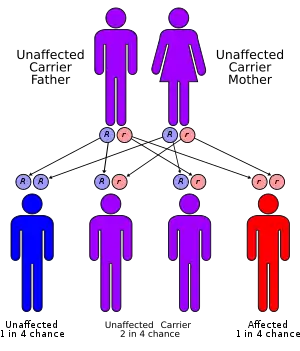Bietti's crystalline dystrophy
Bietti's crystalline dystrophy (BCD) is a rare autosomal recessive[2] eye disease named after G. B. Bietti.[3]
| Bietti's Crystalline Dystrophy | |
|---|---|
| Other names | Bietti crystalline corneoretinal dystrophy[1] |
 | |
| Bietti's crystalline dystrophy has an autosomal recessive pattern of inheritance. | |
BCD is a rare disease and appears to be more common in people with Asian ancestry.[4][5][6]
Presentation
Symptoms of BCD include:
- Crystals in the cornea (the clear covering of the eye)
- Yellow, shiny deposits on the retina
- Progressive atrophy of the retina, choriocapillaries and choroid (the back layers of the eye). This tends to lead to progressive night blindness and visual field constriction.
Genetics
BCD is inherited in an autosomal recessive manner.[2] This means the defective gene responsible for the disorder is located on an autosome, and two copies of the defective gene (one inherited from each parent) are required in order to be born with the disorder. The parents of an individual with an autosomal recessive disorder both carry one copy of the defective gene, but usually do not experience any signs or symptoms of the disorder.
BCD is associated with mutations in the CYP4V2 gene.[2] The nematode C. elegans has a duplicated gene (cyp31A2 and cyp31A3) that are orthologous of the human gene. These genes code for cytochrome P450s involved in fatty acid synthesis.[7]
Treatment
At this time, there is no treatment for BCD. Genetic studies are being conducted to find treatments for patients with BCD.[8]
References
- Online Mendelian Inheritance in Man (OMIM): 210370
- Li A, Jiao X, Munier FL, Schorderet DF, Yao W, Iwata F, Hayakawa M, Kanai A, Shy Chen M, Alan Lewis R, Heckenlively J, Weleber RG, Traboulsi EI, Zhang Q, Xiao X, Kaiser-Kupfer M, Sergeev YV, Hejtmancik JF (2004). "Bietti crystalline corneoretinal dystrophy is caused by mutations in the novel gene CYP4V2". Am. J. Hum. Genet. 74 (5): 817–26. doi:10.1086/383228. PMC 1181977. PMID 15042513.
- Bietti G (1937). "Ueber familiaeres Vorkommen von 'Retinitis punctata albescens' (verbunden mit 'Dystrophia marginalis cristallinea corneae'), Glitzern des Glaskoerpers und anderen degenerativen Augenveraenderungen". Klinische Monatsblätter für Augenheilkunde. 99: 737–757.
- Furusato E, Cameron JD, Chan CC (2010). "Evolution of Cellular Inclusions in Bietti's Crystalline Dystrophy". Ophthalmol Eye Dis. 2010 (2): 9–15. doi:10.4137/OED.S2821. PMC 3045089. PMID 21359135.
- Sahu, DK; Rawoof, AB (2002). "Bietti's crystalline dystrophy". Indian J Ophthalmol. Medknow. 50 (4): 330–332. PMID 12532504.
- Welch, RB (1977). "Bietti's tapetoretinal degeneration with marginal corneal dystrophy crystalline retinopathy". Trans Am Ophthalmol Soc. 75: 164–79. PMC 1311548. PMID 306693.
- Benenati G, Penkov S, Müller-Reichert T, Entchev EV, Kurzchalia TV (May–Jun 2009). "Two cytochrome P450s in Caenorhabditis elegans are essential for the organization of eggshell, correct execution of meiosis and the polarization of embryo". Mech Dev. 126 (5–6): 382–93. doi:10.1016/j.mod.2009.02.001. PMID 19368796. S2CID 17220562.
- "Facts About Bietti's Crystalline Dystrophy | National Eye Institute". nei.nih.gov. Retrieved 18 October 2018.
External links
- Bietti's crystalline dystrophy at NIH's Office of Rare Diseases